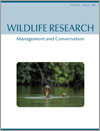Context. For conservation of any species, we need baseline data that will guide conservation planning strategies. Identifying plant resources used by animal species for food and shelter is the first important step towards fauna conservation. The second step is to determine the extent and distribution of these resources and thus identify prime habitat or habitat that could be improved through suitable management actions. This information provides the necessary spatial targeting required to make the most of few resources and a shortage of time.
Aims. Applying this model approach, we identified plant species used as food or shelter resources by the conservationally significant quokka (Setonix brachyurus) across Rottnest Island, Western Australia in the aftermath of the hottest and driest summer on record.
Methods. Dietary analysis was carried out using microhistological examination of plant cuticle remains from faecal samples for 67 locations across the island. Plants acting as diurnal rest shelters (n = 73 sites) were identified through observation of individuals flushed during surveys. Identifying key resources requires both a comprehensive analysis of the current use, as well as knowledge of availability of resources to determine selectivity. We therefore compared food plants or rest sites with a comprehensive survey of floristic diversity and abundance for 210 stratified-randomly located sites across the island.
Key results. We identified eight plant species that quokkas fed on preferentially and identified four plant species that were the principal shelter sites. We then used hyperspectral remote sensing data to map the distribution of these plant species to quantify their distribution and identify key habitat areas.
Conclusions. Understanding resource limitation over the most physiologically challenging time of the year provides important information for quokka conservation. Quokkas prefer Malvaceae species as food plants, and use dense, abundant shrubs for shelter.
Implications. Quokkas appear to have shifted their use of food plants since a previous study (50 years ago), likely reflecting modification of island vegetation due to anthropogenic influences, fire and herbivory over time. In the face of changing climate, this information will serve as an important guide towards conservation management actions on the island (e.g. future planning of revegetation and habitat protection/enhancement).





